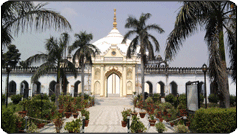Shah Najaf Imambara
Amongst the Nawabs of Awadh, it was the sixth Nawab, Saadat Ali Khan (1798-1814) who proved to be the most efficient in the administration and collection of revenue through the Amani system, introduced by him. He was also the first to set up a royal treasury with a reserve fund, to which he left a sum of fourteen crores at the time of his untimely death, despite his love for horses and construction and purchase of palatial buildings.
Some historians believe that his intention of amassing such large wealth was to buy back the territories taken away from him by the British, that earlier formed part of the Nawabi rule in Awadh. One narration asserts that it was the frustration of the British, in not being able to win him over for their financial devices, that the Resident conspired with the unfaithful servants of the Nawab to get him poisoned, resulting in his death on July 12, 1814.
The conspiring angle may or may not be true, but later developments do prove that the British had an eye on Saadat Ali Khan's wealth and were instrumental in allowing the next Nawab, Ghazi-ud-Din Haider to squander his father's wealth, so earnestly accumulated, for the advantage of the East India Company. According to John Pemble, they extracted a loan of ten crores eighty lakh rupees on six percent interest from him in October 1814 for the Nepal war. In March 1815 they took another loan from the Nawab for meeting out the expenses of another war.
The British flattered the Nawab to the extent of coaxing him to declare himself the King of Awadh on October 19, 1819, and become independent of the Moghuls (who had actually appointed his ancestors as their Nawab Wazir). At this time they also changed his honorific address from 'His Excellency' to 'His Majesty'.
Thereafter, in 1826 the Company demanded the King to invest upto one crore and fifty lakh rupees in bonds as his contribution for the Burmese war. They also usurped another crore left with the East India Company by Bahu Begum, the wife of the third Nawab, Shuja-ud-Daulah and the grandmother of Ghazi-ud-Din Haider, who had stayed and died at Faizabad. Actually this amount should have been inherited by the ruling Nawab.
Since interest on loan was not permitted in Islam, agreements were recorded for utilising the amount of interest accrued on loan given to the Company, for payment of wasiqa (perennial pension) to certain nominated relatives, proteges and servants of the Nawab's household (and later their heirs) and towards grants for maintenance of specified religious buildings and meeting the expenses connected with the observance of ceremonies and festivals held therein.
Shah Najaf, an Imambara built by Ghazi-ud-Din Haider is one of the major beneficiaries of loan agreements between the Nawabs / Kings of Awadh and the British Resident as the representative of the Company receiving these loans. [Later, the Kings, Naseer-ud-Din Haider and Mohammed Ali Shah also provided loans to the Company]. The commitments of the Company were later taken over by the British government and transferred to the Uttar Pradesh government after Independence, in consequence of the conditions of transfer of power.
Ghazi-ud-Din Haider built the Imambara Shah Najaf at a place called Paltan Ghat on the banks of river Gomti, as a token of his devotion to Caliph Hazrat Ali, the husband of Fatima, the favourite daughter of Prophet Mohanmmed. It is supposedly a replica of his mausoleum at Najaf-e-Ashraf in Arabia. Hazrat Ali is also known as Shah-e-Najaf (the Lord of Najaf). The large dome of the Imambara is characteristic, because it is so unlike the other domes which have a slender neck like drum at the base and are onion shaped. [The Imambara has a portal on the front and there is one built at the rear of the Imambara which faces the river].
A mosque and a house for his wife Mumtaz Mahal were also built close to the Imambara by Ghazi-ud-Din Haider. The house was later demolished in 1913 when a road was constructed on the riverside.
Shah Najaf Imambara is also called Karbala, because within its main hall lie the mortal remains of its builder, Ghazi-ud-Din Haider, who wished to be buried here. It also contains the graves of his wives, Mubarak Mahal (died 1849), Sarfaraz Mahal (died 1878) and Mumtaz Mahal (died 1896).
The Shah Najaf Imambara in Hazrat gunj presents a spectacular view when it is profusely decorated and illuminated on the birthday of Hazrat Ali on the 13th of Rajab, and between 7th and 9th Muharrum, according to the lunar calendar.
Source:
Hindustan Times, City Scan, A Time in History
Wednesday 24.9.1997 — Shah Najaf Imambara-Royal Tribute to Hazrat Ali

